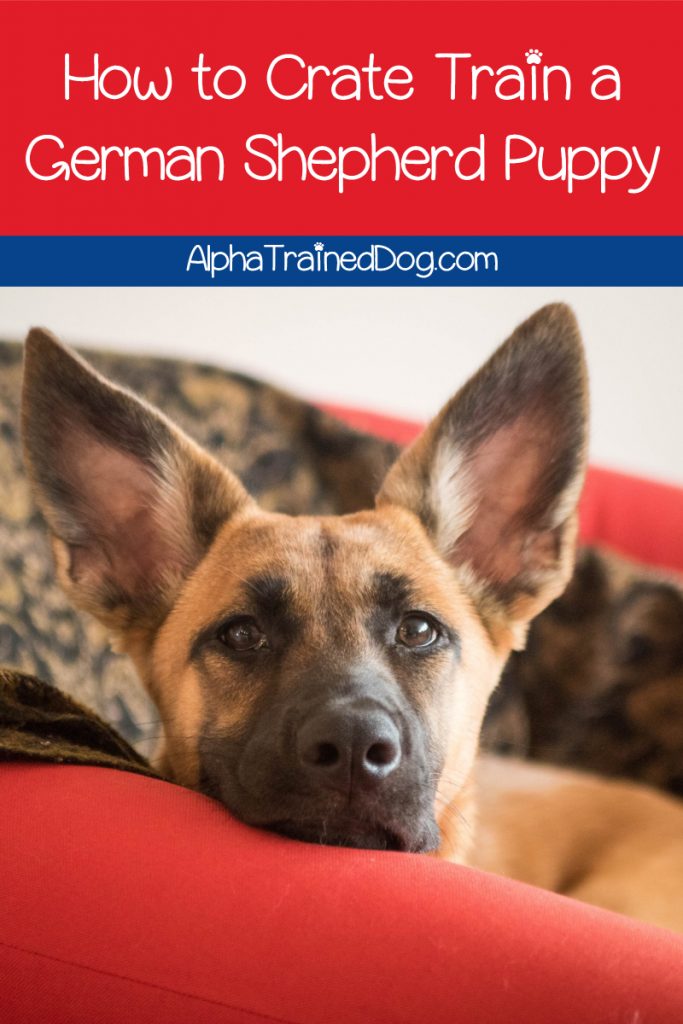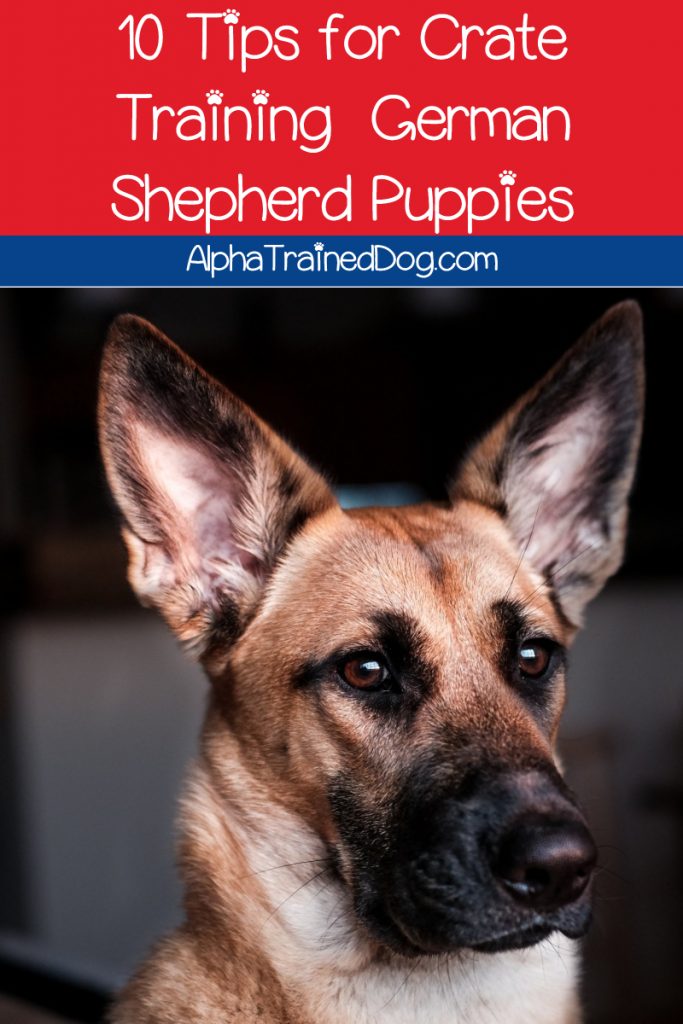Want to learn how to crate train a German Shepherd puppy?
Then you’re in the right place!
Teaching your dog to be comfortable in a crate will make pretty much all other aspects of basic dog training so much easier.
Keep on reading to discover 10 tips that will make GSD crate training easier than ever!

How to crate train a German Shepherd puppy?
Owners often see crates as something “cruel,” and they are reluctant to use them.
However, dog crates have many potential benefits.
You can use them to housebreak your puppy or make sure that your puppy doesn’t get into trouble when you leave him unsupervised for 10 minutes.
In addition to this, dogs and puppies need their own place, where they can retreat when they feel anxious, scared, or tired.
The crate is excellent because it mimics a dog’s den and creates a feeling of securing and safety in your puppy.
Not to mention that taking a dog to a vet or transporting them in case of an emergency will be a piece of cake if your pet is crate trained.
So, let’s see how you can do it.

FYI, this post contains affiliate links. If you make a purchase through these links, we earn a small commission at no extra charge to you.
#1 Choose a crate
Your first step in crate training your German Shepherd puppy would be to choose the best crate.
Nowadays, you have such a wide variety of options in terms of style and material that most owners feel overwhelmed.
The most crucial element is the size. The crate should be big enough for your puppy to stand up, turn around, and stretch comfortably.
Otherwise, your pooch is going to use a portion of the crate as a toilet, which doesn’t suit your purpose.
However, do not fret if you’ve already got a big crate. You can place boxes or something durable to make it narrow.
Need a recommendation? We like this one, below:

#2 Find the right place for the crate
So, you’ve chosen the crate, and the question is where you should place the box.
For one, you don’t want your puppy to feel excluded from the rest of the family, and you must keep an eye on him during training. But your puppy also requires some peace and quiet.
So, dog specialists recommend that you keep the crate in a busy part of the house during the day.
At night, you might move the box to your bedroom so that your puppy won’t feel alone.
In addition to this, the crate should not be away from radiators, direct sunlight, or drafts.
Check out the video below for some tips:
#3 Make it cozy
Your goal is to make your puppy think of his crate as a comfortable, secure, and cozy place. As such, you can let your puppy stay in a barren box.
So, you’ll want to put some bedding inside, a water bowl, and toys.
Choose durable, hard-to-chew bedding since a puppy can tear blankets to bits out of boredom and choke on the pieces. We like this one:

Squeaky toys and toys with chewable parts are also out of the question. Instead, try crate-safe chew toys such as Kong.
In addition to this, get some mounted water bowls so that the little one can’t turn it down and play with the water.
#4 Get the puppy comfortable with the crate
After we’ve covered the essentials, it’s time to start crate training your German Shepherd puppy.
First, don’t put your puppy inside the crate and leave him alone. That’s going to be a big mistake.
We’re going to take things slowly so that the little one acclimates to the box and establishes a positive connection with it.
To do that, you must get some high-value treats that will make your dog go crazy for them (see the video below for tips).
Since you’re going to need a lot of these tasty bits to crate train your puppy, it’s an excellent idea to break them down into small pieces to avoid overfeeding.
Place such a piece in front of the crate while your puppy is watching you. Let Puffy come near the crate, sniff, and eat the food. Once your puppy does it, praise him enthusiastically.
Then continue to place the treat further and further into the crate until your puppy has to get all the way inside to retrieve them.
Praise Puffy and show him what a good boy/girl he is.
#5 Feed your puppy inside the crate
Once your pooch is going all the way inside the crate and doesn’t show signs of discomfort, you can start feed Puffy inside the box.
Open the crate’s door, place the bowl inside, and let your pooch enter to feed.
Do not close the door, but wait for your German Shepherd puppy to finish eating. Then praise Puffy and play with him as a reward.
By doing this, you’re establishing the crate as a place where good things happen.
#6 Close the crate’s door
By now, your puppy should be comfortable spending time in his crate. So, it’s time to close the door. You’re going to do it in stages:
- Wait for your puppy to enter the crate on his own.
- Half-close the door for a second and open it right away.
- Continue to close the door slowly.
- Once you have the door fully closed, start to increase the time between closing and opening the door. Start with one second, then two, three, and so on.
- Once your dog is comfortable with you closing the door, you might start locking it.
#7 Walk away
So, your German Shepherd puppy is happy in his crate even with the door closed. However, you’re still in the room where Puffy can see you.
It’s time to step out and see how Puffy does without you around:
- Close the door to the crate and walk away for one second.
- Then come back, but don’t pay attention to your puppy.
- Practice by increasing the time you’re gone from the room.
Don’t leave your puppy too long too quickly. If your German Shepherd is whining in the crate, and you come back, you’re establishing a precedent.
Your German Shepherd puppy will know that crying or whining is a great way to make you pay attention to him and come back.
#8 Leave the house
Since you’re not going to stay home forever with your puppy, you have to get him used to you leaving the house.
Here’s what you do. You tire out your puppy, put him in the crate, lock it up, and leave the house. But just for a second and then you come back inside.
Remember that you mustn’t interact with your puppy when you come back.
You don’t want to make it as if your comings and goings are something important. Otherwise, your puppy will get anxious when you go out of the door.
#9 Keep crate training at night
You want your German Shepherd puppy to sleep through the night once you close him in the crate. So, you must play with Puffy until you exhaust him.
That’s the one fool-proof way to ensure that you won’t be woken up in the wee hours of the morning by a German Shepherd puppy crying in his crate.
In addition to this, don’t feed or offer water up to 3 hours before bedtime. Or your puppy will wake you up in the middle of the night.
Remember to take your puppy outside to do his business before bed.
Once you lock up your German Shepherd puppy in his crate, you must ignore him if he starts crying.
Otherwise, you’ll teach him that whining/crying will bring you back. As a result, he will cry louder next time to attract your attention.
Of course, your German Shepherd puppy might be crying at night because he needs the bathroom.
Then you’ll have to take him outside and then back to bed. Or you can set up your alarm every 3-4 hours for bathroom breaks if your puppy makes a mess in the crate.
#10 Don’t use the crate for punishment
Finally, you mustn’t lock your puppy in his “den” as a form of punishment.
Puppies or older dogs don’t connect the “crime” with being punished. All you are going to achieve is to make your little anxious and afraid of his “den.”
In addition to this, you mustn’t leave your pooch more than he can handle. As for how long you can leave a German Shepherd in a crate, it depends on your puppy’s age.
Young puppies shouldn’t be left in the crate for more than two hours because they are going to make a mess and feel alone and scared.
Once your puppy grows up, he can spend around 4-6 hours in his crate. But you have to make it up to your pet once you come home with some quality petting time.
Crate training is something that you must do slowly and do it right if you want to reap the benefits.
It’s not a tool for punishment or a way to keep your dog of the way whenever Puffy is bothering you.
The crate is your dog’s safe place, and you must teach your puppy to be happy inside when you’re gone.


I really wish I’d crate trained our pup when we first adopted him. Twelve years later and now that he’s in his senior dog years we’re regretting it! This is so helpful!
These are great tips!We have a 4 year old German Shepherd!
Aww german shepherd puppies! Great post on how to train them from a young age.